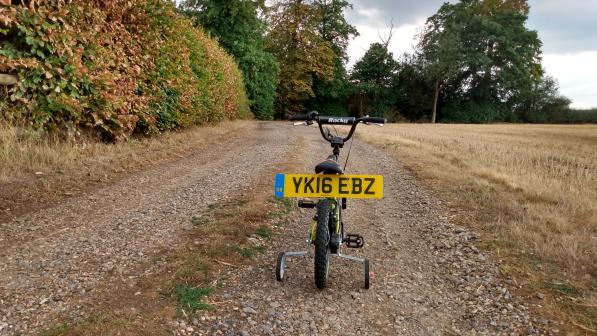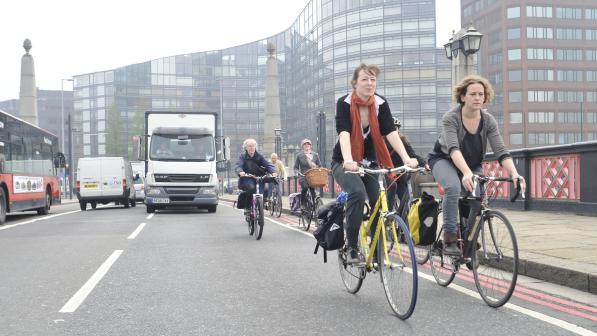What are Cycling UK’s views on regulating cyclists’ behaviour?

On occasion, we hear calls for rules and legislative measures on cycle safety that would, ironically, be most unlikely to improve overall casualty rates either among cyclists or other road users; and, in the likely event that they would suppress cycling, prove detrimental to public health.
This includes making cycle helmets or hi-viz clothing compulsory, a subject we discuss in a separate article on what are, in our view, legally prejudicial rules in the Highway Code.
The health benefits of cycling are known to outweigh the risks by far, which means that if the Government were to introduce any measure that would reduce cycle use by even a fraction of a percent, it would shorten more lives than it could possibly save. It could also increase the risks for people who keep cycling by eroding the benefits of the ‘Safety in Numbers’ effect.
This is why we are urging the Government to avoid taking steps in the name of ‘cycle safety’ that could reduce cycle use. Our recommendation in this respect not only relates to personal safety equipment such as helmets and hi-viz, but also to some road traffic rules and the perennial calls for wholly disproportionate and unworkable regulatory measures such as mandatory training, testing and licensing for cyclists.
These calls, of course, are often inspired not so much by ‘cycle safety’, but in the unfounded belief that cyclists cause havoc and harm on the roads, and that the public and pedestrians in particular need to be protected from them.
We must emphasise here, though, that Cycling UK does not condone irresponsible or law-breaking behaviour by cyclists. In particular, we urge cyclists to behave responsibly by:
- being aware of the requirements of motorists and making their intentions clear;
- ensuring they (or their children) are competent to ride in traffic;
- obeying traffic signals and signs unless this places them in direct danger;
- ensuring that they and their cycles are visible at night;
- maintaining their cycle so as not to cause a danger to themselves or others.
See our article on what's legal and what's not on a bike for more.
Nevertheless, we must stress too that there is no evidence to suggest that cyclists are any more prone to irresponsible behaviour than any other road user group. On the contrary, we note that cyclists and bus drivers are the road users who are least likely to have ‘contributory factors’ attributed to them by the police when they are involved in collisions (Reported Road Casualties Great Britain, Table RAS 50005).
Despite this, we know that, in general, drivers tend to stereotype cyclists negatively. While they may not feel aggressive or actively hostile towards them, research has found that drivers can be critical of cyclists’ actions without understanding why they behave as they do, find them unpredictable, see them as an ‘out group’ who all exhibit the same ‘faults’, and even feel stressed by their vulnerability.
Cyclists are also:
- disproportionately represented in road casualty statistics;
- vulnerable road users when compared to motor occupants;
- when involved in collisions more likely to be the victim than the perpetrator; and
- road users who cause little damage to themselves or others, including pedestrians.
Cyclists’ vulnerability and the relatively low risk they pose to others
- From 2012 to 2016 (GB), about 1.7% of all trip stages by private transport were made by cycle (NTS (National Travel Survey) Table 0304), but cyclists represented over 6.2% of reported road fatalities and about 14.4% of serious injuries (RAS Table 30001)
- In 2016, out of the 14,668 collisions involving a car and cycle, no car occupant died. Fifty cyclists were killed, however. (RAS Table 40004).
- In 2016 (GB), 11,783 cycles were involved in incidents in which a police officer assigned one or more ‘contributory factors’ (CFs) to at least one of the parties at the scene. They assigned 138 CFs for ‘disobeying an automatic traffic signal’ to the cycle, i.e. to just over 1% of them - about the same percentage as it was for cars; and 236 CFs for ‘not displaying lights at night or in poor visibility’ to the cycle, i.e. to 2% of them. (RAS Table 50005).
- From 2007 to 2016, the vast majority - 98.6% - of killed or seriously injured (KSI) pedestrians in collision with a vehicle in any location were hit by a motor vehicle. (RAS Table 40004).
- In 2016, of the 290 pedestrians who died in collisions in urban areas (RAS Table 40004), only two were hit by cycles (0.7%), neither on the pavement or verge.
- From figures we requested from the DfT, we calculate (in absolute numbers) that, on average a year from 2007 to 2016 (GB), cycles were involved in only 0.4 pedestrian fatalities on the footway/verge, and about 19 serious pedestrian injuries. No pedestrians were killed in collision with a cycle on the footway/verge in 2007, 2009, 2011-2013 inclusive, in 2015 or 2016.
- From 2007 to 2016, FOI figures show that 98.9% of pedestrian fatalities and 95.6% of pedestrian serious injuries that happened in collisions on a footway/verge involved a motor vehicle.
- From 2007 to 2016, FOI figures show no pedestrians were killed by red light jumping cyclists, while around five a year (50 in total) were killed by red light jumping drivers or motorcyclists. For pedestrians hit by red light jumping vehicles, just 7.6% of those slightly injured, and 5.4% of those seriously injured, involved cycles. The other 92%-95% involved motor vehicles.
Note: unless otherwise stated, the figures above are based on data from the Department for Transport’s (DfT) annual Reported Road Casualties Great Britain (RAS). FOI figures come from requests we made via the Freedom of Information Act.
Figures we requested from Transport for London (TfL) suggest that, from 2007 to 2016, despite the significant rise in cycling’s modal share into London (with journey stages up by 56% over the period) - and bearing in mind the particularly heavy concentration of pedestrians, cyclists and traffic lights:
- 16% of pedestrians injured or seriously injured by red light jumping involved cyclists. The rest (84%) involved red light jumping by drivers or riders of motor vehicles.
- In particular, red light jumping car drivers were involved in seven pedestrian fatalities over the ten-year period in total.
The need to investigate the reasons behind offending behaviour
To gain widespread respect from cyclists, road traffic rules and their enforcement need to protect, and not undermine, cyclists’ safety. Cyclists should never be forced into choosing between acting legally and protecting themselves (e.g. by riding on a footway to avoid a lorry or moving safely into open space at signalised junctions rather than waiting for the following traffic to accelerate into that junction when the lights turn green).
Hence, it is important to consider the reasons behind any offending behaviour and to address these. In the case of cyclists, they may include: age, inexperience or the fear of on-road riding, a lack of cycle training, poor infrastructure, unhelpful traffic regulations etc.
By way of example, if footway cycling is proving to be a nuisance somewhere, it makes sense for the highways authority to find out why cyclists are not using the legal route. Reducing speeds, installing a cycle link or redesigning a junction may be enough to eliminate the problem.
Need for road traffic rules and their enforcement to protect, not undermine, cycle safety
In Cycling UK’s view, road traffic rules and their enforcement must protect, not undermine, cyclists’ safety. Where conflicts arise, the police should exercise discretion in enforcing the rules, until such time as they can be amended.
Although we stress that Cycling UK does not condone red light jumping, we acknowledge that, in some circumstances, it can be a safer option - in other words, complying with the traffic rules which govern junctions can sometimes be contrary to the interests of cycle safety. We would, however, far prefer to see this problem resolved by new rules on junction priority.
As for pavement cycling, when Fixed Penalty Notices (FPNs) for breaching S72 of the Highways Act 1835 were first introduced in England and Wales, cycling organisations (including Cycling UK) asked for assurance from the Government that the penalty would be applied fairly and only used when the behaviour put pedestrians at risk.
We received such confirmation from the then Home Office Minster in 1999, Paul Boateng MP, who stated in a letter to Ben Bradshaw MP that the introduction of FPNs: “… is not aimed at responsible cyclists who sometimes feel obliged to use the pavement out of fear of the traffic, and who show consideration to other pavement users when doing so. This is not a clamp down on responsible cycling, and I know the police service too do not see it in that way.” (Paul Boateng MP to Ben Bradshaw MP, 9/7/1999).
In 2014, this advice and a reminder that the police should use their discretion over fining people for cycling on the pavement was re-circulated to police forces, and endorsed by the then cycling minister, Robert Goodwill MP.
Cycling UK urges the Government to uphold this approach. If people (especially children) are riding on the pavement because they are genuinely scared of the road, it is important not to treat them like criminals, providing they maintain a safe and respectful speed and distance from any pedestrians.
We stress that we do not support pavement cycling or, in most locations, the conversion of footway space to cycle tracks either. This is never an ideal solution and, in built-up areas, it is almost invariably the wrong one.
Cyclist licensing/compulsory training & insurance
Exaggerating the level of irresponsible behaviour among cyclists, and reluctance to put the consequences of it in perspective, are among the most obvious symptoms of negative stereotyping. They also lead to recurrent calls to regulate cyclists by introducing a testing and licensing system, and making third party liability insurance compulsory.
Cycling UK believes this would have little, if any, positive effect on road safety. As discussed above, cycling is an inherently benign mode of transport, and those who indulge in reckless and potentially harmful behaviour do not typify cyclists in general.
In countries famed for their high levels of cycle use and cycle safety, cyclists are not expected to be tested, licensed/registered etc. Prime examples of this are the Netherlands and Denmark.
A variety of regulatory systems has been introduced in other countries or in cities elsewhere, but subsequently abolished (e.g. in Toronto and Switzerland – see case studies below); either that, or their main aim was or is to tackle bike theft through registration (e.g. in Japan), rather than irresponsible riding behaviour.
Cycling UK’s arguments against compulsory regulation for cyclists are based on practicalities, likely impact and proportionate response. Several of the concerns and disbenefits we identity have, in fact, led Government ministers to reject calls for compulsory regulation of various kinds over the past few years. [1], [2], [3], [4].
In our view, compulsory regulation would be:
Costly and disproportionate: at around 25 million, the number of people aged 5+ who own a cycle in Great Britain (NTS Table 0608) is not much less than the number of licensed private cars (29 million+, according to Table VEH 0103 of the Government's vehicle licensing statistics). A licensing system would thus impose a significant extra burden on the taxpayer, and one that would not prove cost-effective in terms of road safety given the negligible harm cyclists do.
Impractical to administer and enforce, especially given the numbers of children who cycle or own a bicycle. In fact, they are much more likely to be bicycle-owners than adults, according to the National Travel Survey (NTS Table 0608). Measures to oblige every child (or even children from a certain age) to carry a licence ready for inspection by the police are wholly unrealistic, inoperable and unenforceable. Regulating child cyclists, in fact, caused such serious problems that it was one of the reasons behind Toronto’s decision to revoke its bicycle licensing bylaw (see case study below).
Also, as bicycles change hands more readily than motor vehicles, keeping the system up to date would be very difficult. Moreover, the police are under-resourced, and enforcing a licensing system for cyclists, child and adult alike, would stretch them yet further. Even when supplied with a driver's licence plate number and full details, many police forces already find it challenging enough to pursue each and every report of bad driving.
A barrier to the uptake of cycling: cycling is so healthy and environmentally-friendly that it makes no sense to put anything in the way of people who are interested in taking it up. Newcomers or occasional cyclists may be put off if they have to apply for a licence, register their machines, purchase insurance and undergo compulsory training before they can pop on their bike for a quick trip to the shops or even dream of a cycle outing with their family.
Complex to introduce: the Vehicle Excise and Registration Act 1994 provides for the registration of mechanically propelled vehicles, but not for cycles or cyclists, meaning that new, and probably convoluted, legislation would be needed if the Government decided to regulate cyclists/cycling/cycles in a similar way. It would also require extensive upgrades to the relevant computer systems.
Public liability insurance
Cycling UK does not want anyone to face barriers if they decide to cycle somewhere, and this includes making third party liability insurance compulsory. We have already stressed that cyclists do little harm to others, and are less likely to contribute to a collision than the driver of any car involved. Also, given their vulnerability, most do not ride negligently because they are more than likely to come off worse in a collision with a motor vehicle than its driver or passengers.
Nonetheless, we encourage cyclists to take out public liability insurance in the unlikely event that they do cause injury or damage to anyone else or any property in a road traffic incident. All our members, in fact, are automatically covered up to £10 million, and we offer a discounted rate to members of affiliated groups.
Our views on ‘presumed liability’ are also relevant here. This helps correct for the imbalances in power and vulnerability among road users in the context of liability for injury or damage to third parties, and is the approach taken in the majority of European countries.
Case studies:
City of Toronto, Canada
In 1935, Toronto introduced a bylaw requiring residents who owned and used bicycles on the city’s highways to buy a licence for their bikes. It was, necessarily, a complicated system, and involved much paperwork, visits to police stations, bike inspections etc. In 1957, the bylaw was repealed, with the City stating that it “… often results in an unconscious contravention of the law at a very tender age” and noting the poor public relations it caused between police officers and children.
On occasion since then, the city has thought about reintroducing the bylaw, but has each time rejected the idea, mainly citing how difficult it is to keep the database up to date and license children, and its basic failure to modify the kind of behaviour it wanted to target.
Switzerland
Very early in its cycling history in the 1890s, Switzerland obliged all cyclists to purchase a metal bicycle licence plate unique to the bike and its owner, both of which were thereby registered. This was an expensive and complicated system (involving either the municipality or the police), and was replaced by the mandatory Velo-Vignette in 1989.
Purchasing a Velo-Vignette, a self-adhesive sticker, was compulsory and covered cyclists with third party liability insurance. The stickers were valid from 1 January one year to 31 May the next, and non-compliance was penalised with a fine. Obligatory registration and the central registry dealing with it was disbanded, however.
The Velo-Vignette was finally abolished from 1 January 2012 (except for e-bikes capable of exceeding 25 km/h). Its high cost and administrative burden had been repeatedly questioned and 90% of cyclists were found to be covered by private liability insurance in any case.
‘Road tax’
Unjustified claims that virtually all cyclists misbehave themselves on the roads often trigger calls for them to pay their ‘fair share’ of ‘road tax’.
This is illogical for many reasons: i.e. as we know, there is no such thing as ‘road tax’, but VED based on fuel type and CO2 emissions; VED revenue goes into general taxation (at least at present), and has little bearing on road user behaviour; cyclists do very little physical damage to the roads; and most are also drivers and/or income/council taxpayers who contribute financially to national and local road maintenance and infrastructure anyway.
The prospect of a new ‘Road Fund’ from 2020, financed by VED revenue for new cars, is of some concern to Cycling UK, however. This move could breathe more life into the argument that ‘cyclists don’t pay road tax’, making it all the more important to address the negative stereotyping and misunderstandings that cycling unfortunately attracts from some sections of the public and media.











